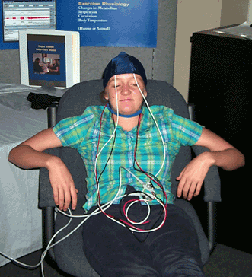H10 Hemispheric EEG

Derived from original work created by Pr Jean-Frans Lambert and Nicole Chantrier, Institut d’Enseignement istance / Universitaris 8- Saint-Denis France
Experimental Objectives
- To demonstrate how alpha rhythm (around 10 Hz) takes place of a more rapid rhythm called beta (around 15 to 40 Hz).
- To observe various stop reactions that represent temporary interruptions of alpha rhythm, following a sensory stimulation or change in attitude (attention focus), that give way to beta rhythm.
- To analyze the spectrum of frequencies that constitute alpha rhythm.
- To compare the distribution of alpha rhythm between the two cerebral hemispheres.
Tasks Performed by the Student
Subject will:
- sit in a relaxed state with eyes closed/open at variable intervals of eye opening,
- listen to various types of auditory stimulation, and
- close eyes and perform mental math.
Videos
Biopac Student Lab Student Download
Student Prep & Distance Learning
Click the link(s) below for sample data and/or lesson procedure video(s), BSL PRO Lesson procedures (PDF) for human lessons*, and graph template files (*.gtl) for BSL PRO Lessons. If more than one .gtl is available, download the .gtl with the _suffix to match BSL version and hardware.
Lesson Hardware
This lesson requires a Biopac Student Lab (BSL) System and the following hardware. If your BSL System does not include all hardware items, expand your system by selecting required items below. For more details, review the Lesson: L# BSL Lessons - see the Lab Manual or launch BSL; A# and H# BSL PRO Lessons, click the PDF link above to review full setup, recording, and analysis procedures.
| Item | Name | Cart |
|---|---|---|
| SS2LB | Lead set, shielded, BSL | Add to Cart |
| EL503 | Disp. Gen-purp electrode 100/pk | Add to Cart |
| ELPAD | Abrasive Pads 10/pk | Add to Cart |
| GEL1 | Electrode gel 50 g | Add to Cart |
Stay Connected